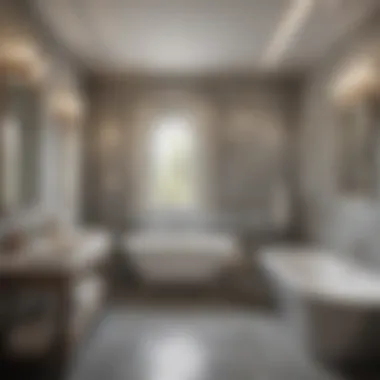Innovative Senior Bathroom Remodeling for Comfort & Safety


Intro
As society progresses, the need for effective and thoughtful designs in the home becomes increasingly imperative, especially in the bathroom. This space must accommodate the unique challenges faced by seniors. The process of remodeling a bathroom for seniors goes beyond basic aesthetics. It embeds principles of safety, comfort, and accessibility. In this piece, we will look at how to create a bathroom that both looks appealing and meets the functional demands of older adults.
Through an examination of design inspirations and practical product recommendations, we will offer guidance for homeowners and designers alike. The aim is to create a space that enhances quality of life without sacrificing style.
The bathroom should be a sanctuary, a place where comfort meets functionality. A well-thought-out design can significantly reduce risks associated with falls and accidents while promoting ease of use. This article will discuss trending styles and color palettes, followed by product recommendations that cater specifically to seniors’ needs.
Ultimately, a successful remodel merges innovative design elements with a keen understanding of user requirements. This will ensure a safe and pleasant experience for seniors as they navigate their daily routines.
Understanding the Need for Senior Bathroom Remodeling
Remodeling a bathroom to cater to seniors involves thoughtful consideration of both functionality and safety. Older adults often face unique challenges as they age, and these can greatly impact their daily routines. A well-designed bathroom is essential not just for aesthetics but also for enhancing security and independence. By focusing on the evolving needs of seniors, homeowners can create spaces that are not only practical but also vastly improve the quality of life for their loved ones.
Demographics of an Aging Population
The population of older adults is increasing rapidly. According to data from the U.S. Census Bureau, by 2030, approximately one in five people will be over the age of 65. This demographic shift signifies a greater need for homes that can accommodate the elderly. As more individuals choose to age in place rather than move to assisted living, the necessity for accessible living spaces, particularly bathrooms, becomes clear.
With the baby boomer generation reaching retirement age, the expectations of this group can differ significantly from previous generations. They often prioritize comfort and independence, which can be supported through thoughtful remodeling.
Health and Mobility Challenges
Health issues can drastically affect mobility and balance as people age. Common problems include arthritis, reduced vision, and cognitive impairments, which interfere with both ability and confidence in performing daily activities. For instance, slick tile surfaces can pose a risk for falls, which are a leading cause of injury among seniors.
Accessible design can mitigate these challenges. Installing grab bars, a comfort height toilet, and a shower with a bench can mean the difference between maintaining independence or relying on assistance.
The Impact of Environment on Well-Being
The design of a bathroom plays a significant role in the overall well-being of seniors. An environment that considers safety and convenience encourages an enhanced state of mind. A well-lit bathroom with appropriate color schemes can uplift spirits, while easy-to-navigate features can reduce stress. Adequate space is also essential; cramped quarters can lead to anxiety and hinder mobility.
Furthermore, the incorporation of natural light can have psychological benefits. Thus, a senior-friendly bathroom focuses not just on safety features but also on creating a calming and supportive atmosphere.
"A well-designed bathroom for seniors can profoundly enhance their quality of life by fostering independence and safety."
In summary, understanding the necessity behind senior bathroom remodeling requires knowledge of demographic trends, health-related mobility challenges, and the broader impact physical environment has on overall well-being. These elements underscore the importance of designing spaces that not only meet practical needs but also promote a sense of dignity and comfort.
Key Features of an Accessible Bathroom
When remodeling bathrooms for seniors, accessibility plays a crucial role. An accessible bathroom not only enhances safety but also contributes significantly to the overall comfort and independence of older adults. Key features include thoughtful planning of space. This can drastically improve how seniors maneuver their surroundings without feeling constrained.
Width of Doorways and Hallways
The width of doorways and hallways is one of the primary factors in accessible bathroom design. Standard door widths can create challenges for those using mobility aids. A minimum width of 32 inches is recommended to allow easy passage for wheelchairs, walkers, or other devices. Larger hallways also facilitate maneuverability. This is essential not just for mobility aids but also for caregivers who might need to assist.
Planning for wider doorways can seem like a minor detail, but it can significantly affect usability. Transitioning from one area to another should be seamless and worry-free. Many homes with older design might need renovations to achieve this.
Non-slip Flooring Options
Flooring is a critical component of bathroom safety. Non-slip surfaces are vital. Falls in a bathroom can lead to severe injuries, particularly for seniors. Various materials are available that provide traction, such as vinyl, ceramic tiles, or specialized coatings. Each choice comes with its pros and cons.
Consideration of texture and finish also impacts safety. A floor with a matte finish may provide more grip than a glossy one. Keeping the flooring clean and dry is important, but choosing the right materials can help mitigate risks.
Proper Lighting Considerations
Lighting is often overlooked, yet it is essential for safety. An accessible bathroom needs ample lighting, especially near sinks, showers, and other critical areas. Layered lighting, which combines ambient, task, and accent lights, can help illuminate all space evenly.


Moreover, motion-sensor lights are becoming a common choice. They provide convenience and ensure that seniors can navigate safely, especially at night when they may need to use the bathroom.
Installing dimmers may also help customize the light level to personal preference, which can be particularly helpful for those with sensitive eyes.
Proper lighting not only enhances visibility but also boosts confidence, allowing seniors to use their bathroom independently.
In summary, incorporating these key features into an accessible bathroom design facilitates greater independence, comfort, and safety for seniors. It is crucial to consider the entire environment, as little details can make a big difference in daily living.
Essential Fixtures for Senior Safety
The importance of essential fixtures in a senior bathroom remodel cannot be underestimated. These elements significantly enhance both comfort and safety, allowing seniors to maintain independence and reduce the risk of accidents. Understanding which fixtures to prioritize is crucial for anyone looking to create a safe environment.
Grab Bars and Handrails
Grab bars and handrails serve as crucial safety features in a senior-friendly bathroom. These fixtures provide stability and support, especially in areas where slipping is a concern. When placed strategically near toilets, showers, and bathtubs, they can help prevent falls, which are a leading cause of injury among older adults.
Installation should be considered in terms of weight capacity and design. Heavy-duty bars that can bear substantial weight will offer more reassurance to users. Furthermore, the placement should be at the correct height, typically between 33 to 36 inches from the floor, which allows for easy reach. Non-slip grips can also enhance safety.
"Installing grab bars can significantly reduce the chance of falls, providing peace of mind for both seniors and their caretakers."
Comfort Height Toilets
Comfort height toilets are another essential feature. These toilets are slightly taller than standard models, making it easier for individuals with limited mobility to sit down and stand up. This design is particularly advantageous for seniors who might struggle with traditional low toilets due to knee or back issues.
Research shows that comfort height toilets can alleviate strain on the body during use. A height of around 17 to 19 inches from the floor is recommended. Such a height allows seniors to transfer from standing to sitting positions with less effort. Some models even come with additional features like built-in bidets or elongated bowls for extra comfort and utility.
Shower Seats and Handheld Showers
Shower seats and handheld showers represent vital innovations in bathroom safety for seniors. Shower seats provide a resting place while bathing, significantly reducing the risk of falls. They should be stable, portable, and easy to clean. Materials like plastic or aluminum promote longevity and comfort.
Handheld showers complement this arrangement by allowing control over water flow and direction. This flexibility can help seniors wash themselves without needing to stand for too long or reach awkwardly, retaining their dignity while maintaining safety during personal care. Adjustable showerheads that can be raised and lowered offer added convenience.
Incorporating these fixtures into a bathroom not only maximizes practicality but also contributes to an overall sense of well-being and independence for seniors.
Designing for Comfort and Aesthetics
Designing for comfort and aesthetics is a vital aspect of senior bathroom remodeling. It goes beyond mere functionality by addressing the emotional and psychological aspects of the space. A well-designed bathroom should not only be safe and accessible but also feel inviting and pleasant. Therefore, various elements must be considered to create a harmonious environment that meets the needs of older adults while aligning with their taste and preferences.
Color Schemes and Textures
The choice of color schemes and textures plays a crucial role in setting the tone of the bathroom. Softer colors such as pastels and neutrals can promote relaxation and tranquility, which is essential for seniors who may experience higher levels of stress or anxiety. Bright and vibrant colors can also accentuate particular areas or features, helping to create visual interest without overwhelming the senses.
Texture is equally important. Smooth surfaces may be easier to clean, while textured materials can provide better grip and reduce the risk of slipping. The combination of colors and textures should create a warm atmosphere that feels personal and comfortable.
"The power of color can transform a simple space into a refuge. It is key to enhancing both comfort and accessibility in the bathroom."
Personalized écor Elements
Incorporating personal décor elements allows older adults to express their individuality. This might include family photographs, heirlooms, or artwork that resonates with their life experiences. While functionality is significant, personal touches create a sense of belonging and comfort.
Decorative accessories, such as decorative towels, attractive soap dispensers, or specialized mirror treatments, can enhance aesthetics without compromising safety. Furthermore, selecting items that are simple to grasp and operate can prevent frustration and promote independence.
Storage Solutions for Convenience
Efficient storage solutions are paramount in designing a senior-friendly bathroom. Clutter can lead to confusion and potential hazards. Therefore, finding smart ways to organize items is essential.


Wall-mounted shelves or cabinets that are easily reachable minimize bending or stretching, which can be difficult for some seniors. Baskets or bins can help categorize items, making everyday routines smoother.
Implementing pull-out drawers and lazy susans in corner cabinets maximizes space usage and reduces the need to bend down to the floor. This strategy not only enhances safety but also ensures everything is easily accessible and within reach.
Creating a beautiful bathroom that emphasizes both comfort and aesthetics is not just about looks. It involves thoughtful planning and design, ensuring that each choice enhances the overall experience for seniors while making daily activities easier and more enjoyable.
Technological Innovations in Senior Bathrooms
Technological innovations play a crucial role in enhancing safety and comfort in bathrooms designed for seniors. As the aging population continues to grow, these advancements address specific needs, allowing older adults to maintain independence while ensuring a secure environment. Implementing smart technology in bathroom design not only simplifies daily routines but also minimizes risks associated with mobility and health challenges. The integration of these innovations increases accessibility and convenience, ultimately improving the overall quality of life for seniors.
Smart Home Devices for Accessibility
Smart home devices serve as a transformative element in bathroom spaces tailored for seniors. These devices can be controlled remotely or through voice commands, offering seamless interaction for those with limited mobility or dexterity. For example, smart mirrors equipped with voice assistants can provide essential information like weather forecasts or medication reminders.
Another key innovation is the use of smart lighting systems. These systems allow users to customize brightness levels and colors. Such adaptability is beneficial for those with vision impairments, enabling them to navigate the space more confidently. Additionally, motion-sensor lights can illuminate a path automatically, reducing the risk of falls during nighttime bathroom visits.
"Implementing smart home devices can drastically improve the daily living experience for seniors. Accessibility goes hand in hand with modern innovations."
Automatic Faucets and Lighting
Automatic faucets offer considerable advantages in terms of hygiene and ease of use. They eliminate the need for manual operation, a critical factor for seniors with arthritis or limited hand strength. The touchless functionality means that users don’t need to turn knobs, reducing the risk of slipping due to wet hands. This feature is essential, as consistent hand hygiene is vital for preventing infections, especially in older adults.
In addition, automatic lighting can enhance safety. Using motion detectors, lights can automatically turn on and off based on presence, illuminating the bathroom efficiently without the need for physical switches. This capability not only aids in preventing accidents but also fosters independence by simplifying the process of using the bathroom at all hours.
Emergency Alert Systems
Emergency alert systems are an invaluable addition to senior bathroom designs. These systems provide an instant way for seniors to signal for help in case of a fall or other emergencies. Devices can be installed discreetly in the bathroom, allowing users to call for assistance without needing to reach for a phone.
Many modern systems offer wearable options, such as pendants or wristbands, which seniors can wear at all times. This means help is just a push of a button away, increasing peace of mind for both the users and their families. Furthermore, many emergency alert systems integrate with smartphones, enabling caregivers to receive real-time alerts and respond quickly to any issues.
Through the use of these technological advancements, seniors can experience a safer, more user-friendly bathroom environment. By prioritizing comfort and safety via smart solutions, we can empower older adults to navigate their daily lives with more ease and security.
Planning the Remodeling Process
Planning a bathroom remodel, especially for seniors, requires a thoughtful approach. This phase is crucial as it lays the groundwork for creating spaces that genuinely enhance comfort and safety. A well-planned remodel not only addresses immediate needs but anticipates future challenges that may arise. With seniors, factors such as mobility issues, usability of fixtures, and overall accessibility take precedence. Hence, discussing how to systematically plan can lead to significant improvements in day-to-day living conditions.
Assessing Needs and Priorities
Before starting any remodeling project, it is essential to assess the needs of the senior occupant. Each individual’s requirements may vary significantly. Therefore, conversations with family members or caregivers can provide strong insights. Factors to consider include:
- Current and potential mobility issues: Identify any existing challenges that might affect movement within the bathroom.
- Health conditions: Consider chronic conditions or medications that may influence design choices.
- Personal preferences and habits: Understanding the daily routines can help in designing a more functional space.
An effective way to assess these factors is to create a checklist that outlines specific needs. By ranking these needs, homeowners can determine priorities. It helps to engage seniors in this process, ensuring their input is valued.
Budgeting for Senior Remodels
Budgeting is another critical aspect of the remodeling process. A comprehensive financial plan allows homeowners to manage costs effectively without compromising the project’s integrity. To create a realistic budget, start by identifying:
- Required materials and fixtures: Research which products are necessary for senior-friendly adaptations.
- Labor costs: Determine if hiring professionals is required or if the work can be done by family members.
- Contingency funds: Always set aside an extra 10-20% of the budget for unexpected expenses.
Careful budgeting will help maintain financial transparency and minimize stress. This planning offers cost efficiency in selecting materials and hiring services as needed, ensuring that the bathroom remains a safe and accessible space over time.
Selecting Professional Help vs. DIY
Deciding between hiring professionals or undertaking a do-it-yourself (DIY) project hinges on the scope of work and expertise available. Here are some points to consider:


- Complexity of the remodel: For extensive changes such as plumbing or electrical work, seeking professional help is advisable.
- Skill level: If family members have the skills needed, DIY might save money while achieving specific needs.
- Time constraints: Some homeowners may find it beneficial to hire professionals for a quicker completion time.
When a professional is the right choice, seeking referrals and checking certifications can ensure quality results. Conversely, if opting for DIY, utilizing online resources and communities can provide support and encouragement. Using platforms like Reddit or dedicated Facebook groups can offer real-life advice and troubleshooting help from those who have undertaken similar projects.
In summary, planning is not merely a phase but a foundation for a successful senior bathroom remodel. By assessing needs realistically, managing finances wisely, and deciding on the right level of professional involvement, homeowners can create a functional and aesthetically pleasing bathroom that caters to the specific needs of seniors.
Common Misconceptions About Senior Bathroom Remodeling
Bathroom remodeling for seniors is an important topic. Many people have misconceptions about it. These misconceptions can lead to decisions that do not meet the needs of older adults. By addressing these myths, we can help create spaces that enhance safety and comfort. This section will discuss three main misconceptions: that remodeling is only for those with disabilities, the assumption that it involves high costs and limitations, and the belief that it leads to a loss of aesthetic appeal.
Only for Those with Disabilities
One common misconception is that only individuals with disabilities require bathroom remodeling. This belief can be misleading. As people age, their physical abilities tend to change. Even seniors without formal disabilities may face challenges. Simple tasks like getting in and out of the shower or using the toilet become more difficult. A well-designed bathroom can prevent falls and support aging in place. Here, some features can be helpful for all seniors. For example, grab bars, slip-resistant flooring, and higher toilets improve safety for everyone, not just those with disabilities.
High Costs and Limitations
Another myth revolves around the assumption that remodeling a bathroom for seniors is prohibitively expensive. While some changes can have high costs, it is important to note that there are budget-friendly options available. Prioritizing safety and comfort does not mean sacrificing quality. It is possible to select materials and fixtures that fit a budget while still providing essential benefits. Consider choosing a *get* range of affordable fixtures. You can also explore financing options. Many local governments and organizations offer grants and assistance programs to help cover remodeling costs. Remember, investing in a safer bathroom can save on future medical expenses due to accidents.
Loss of Aesthetic Appeal
Lastly, many individuals fear that remodeling for senior safety will negatively impact the bathroom's appearance. This misconception overlooks the advancements in design. Today, manufacturers offer a variety of stylish, functional products that prioritize safety without compromising aesthetics. For instance, modern grab bars come in designer styles, complementing any decor. The right lighting, color choices, and fixtures can enhance the room’s visual appeal. With smart design choices, a senior-friendly bathroom can be both beautiful and practical.
Addressing these misconceptions is crucial. By doing so, homeowners can create bathrooms that are not only safe and accessible but also welcoming and attractive.
In summary, it is vital to understand that bathroom remodeling can benefit all seniors, regardless of disability status. It can also be affordable and aesthetically pleasing. By clearing up these misconceptions, we can encourage more homeowners to consider remodeling projects that truly meet the needs of aging individuals.
Post-Remodeling Considerations
Post-remodeling considerations hold great significance in the context of senior bathroom remodeling. These aspects ensure that the refreshed space continues to serve its intended purpose efficiently, providing comfort and safety for its users. Evaluating how effectively the changes are functioning post-remodeling can greatly enhance the longevity and usability of the bathroom.
Monitoring Safety and Functionality
It is crucial to assess both safety and functionality after the remodeling process. This involves observing how the newly installed fixtures are accommodating daily activities. For instance, grab bars should be tested to ensure they are secure and can support the weight of the user. Similarly, evaluating the ease of access to the shower or bathtub can identify any lingering challenges.
In addition, monitoring the floor space for any hazards is essential. Even with non-slip flooring, if items are left on the ground, they can still cause accidents. Homeowners might consider regular check-ins, perhaps every few months, to gauge if any adjustments are necessary. Striking this balance ensures that the remodel truly meets its goal of safety and comfort.
Routine Maintenance Tasks
Proper maintenance is key to preserving the functionality of a remodeled bathroom. Some routine tasks might include:
- Inspecting the Fixtures: Regularly examine all fixtures such as faucets and toilets to ensure they are functioning correctly.
- Cleaning Non-slip Surfaces: Maintaining the cleanliness of non-slip floors is essential for safety. Dirt and soap can diminish their effectiveness.
- Checking for Water Leaks: It is advisable to check under sinks and around the toilet for any leaking water, which can lead to damage or mold.
- Maintaining Low Light Levels: Ensure that the lighting fixtures are operating properly and replace any burnt-out bulbs.
By incorporating a simple checklist into the routine, homeowners can keep their bathrooms in optimal condition. Consistent monitoring and maintenance will reinforce the investment made during the remodeling phase, ensuring the space remains a safe haven for its users.
"A well-maintained bathroom caters not just to aesthetics, but also to overall safety, enhancing the quality of life for seniors."
Ending
In this article, we have explored the multifaceted dimensions of senior bathroom remodeling with an emphasis on innovations that enhance comfort and safety. The importance of this topic cannot be overstated. As the population ages, the need for bathroom spaces that cater specifically to seniors becomes crucial.
Key Elements
First, addressing the unique needs of older adults is vital in creating functional spaces. Features like non-slip flooring, adequate lighting, and strategically placed grab bars can significantly reduce the risk of falls. These features promote independence, allowing seniors to maintain their routine without excessive assistance.
Benefits of Remodeling
Bathroom renovations provide significant benefits. A well-designed bathroom can enhance the user's quality of life, promoting dignity and confidence. Moreover, these remodels not only improve safety but also increase property value. This dual advantage is often appealing to homeowners, especially those considering long-term residency or selling their homes in the future.
Considerations in Design
When remodeling, it is important to prioritize both functionality and aesthetic appeal. Homeowners should focus on choosing fixtures that are adaptable and easy to use. Technologies like smart home devices can further enhance safety and convenience. Always consider the future needs of residents.
By understanding the impacts of these improvements, homeowners and designers can create environments that truly serve the aging population. Ultimately, investing time and resources into senior bathroom remodeling is a commitment to safety, comfort, and independence that benefits all.
"Thoughtful design can transform a simple bathroom into a sanctuary of safety for aging individuals."
This overarching focus on safety within the context of senior bathroom remodeling is not merely a trend, but a pivotal response to the dynamic needs of our aging society.



